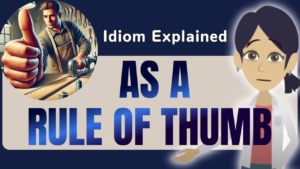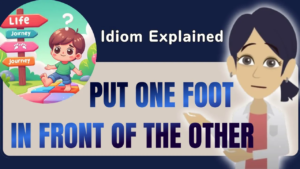Imagine waiting anxiously for news about a job application or a health checkup. You might unconsciously cross your fingers, hoping for a positive outcome. This simple gesture has a name: “fingers crossed.” It’s an idiomatic expression commonly used to convey optimism or the wish for good luck in English. Although the idea of literally crossing one’s fingers might seem straightforward, the expression carries a rich cultural history and is widely employed in casual and professional contexts alike. Understanding such idioms not only makes conversations more engaging but also helps learners connect with English speakers on a deeper, more authentic level.
Why Understanding Idioms Enhances Your Fluency
Idioms are not merely decorative expressions; they serve as tools to convey meaning in subtle and nuanced ways. Mastering them can transform your language skills from textbook-perfect to truly fluent. When you use idioms appropriately, you demonstrate cultural awareness and add an unmistakable human touch to your speech or writing.
- Depth in Communication
By sprinkling everyday conversations with idioms, you effortlessly add layers of meaning and personality to your English. Phrases like “fingers crossed” express hope, while others such as “under the weather” or “beat around the bush” convey experiences and feelings that might be tough to articulate through direct speech. - Cultural Insight
Many idioms have historical or cultural backgrounds that illuminate the traditions of English-speaking communities. Learning where these expressions come from can spark your curiosity and even deepen your understanding of Western cultures and their shared beliefs. - Motivation to Learn
Incorporating idioms in your daily language practice keeps things interesting. Rather than repeating the same vocabulary words, you can experiment with playful phrases. This variety makes learning more engaging and helps you remember new expressions more effectively.
What “Fingers Crossed” Really Means
The phrase “fingers crossed” is a way to express hope or wish for a positive outcome. Instead of outright saying, “I hope everything goes well,” you can say, “I’ve got my fingers crossed!” This idiom is often accompanied by physically placing one finger over the other, although using the gesture is completely optional. The expression resonates with optimism, as though you’re sending a silent plea to fate.
Historical Glimpse
While the exact origin is sometimes debated, many sources attribute the gesture of crossing fingers to early Christian traditions. Believers allegedly crossed their fingers to invoke divine protection or blessings, interpreting the crossing of two fingers as a symbol of unity or faith. Over centuries, the gesture evolved into a widely understood sign of good luck. Although modern usage is more secular, the sense of hopeful anticipation remains strong.
Situations to Use “Fingers Crossed”
- Awaiting Important News
- “I’ll have my fingers crossed for you while you’re waiting on those test results.”
This is a supportive way to say you genuinely hope for a friend’s good outcome.
- “I’ll have my fingers crossed for you while you’re waiting on those test results.”
- Before a Challenging Event
- “Fingers crossed that today’s presentation goes smoothly.”
Whether it’s a job interview, a performance, or a big speech, using “fingers crossed” sets a positive tone.
- “Fingers crossed that today’s presentation goes smoothly.”
- Everyday Conversations
- “I’m crossing my fingers for good weather this weekend!”
This phrase adds an element of lightheartedness when discussing day-to-day hopes.
- “I’m crossing my fingers for good weather this weekend!”
Adding Humor to the Idiom
Idioms can occasionally cause amusing misunderstandings. For example, you might say to a friend, “Fingers crossed you’ll pass your driving test!”, only to have them respond with a puzzled look, asking if they’re supposed to literally twist their fingers. These comical moments often lead to friendly explanations that help clarify the idiom for those learning English.
Here’s a humorous story to illustrate how confusion can arise around “fingers crossed”:
- Personal Anecdote: A coworker once asked me to keep my fingers crossed for him right before a performance review. He took it literally, walking around with his fingers interlocked for half the day, assuming it was some sort of secret motivational trick. When he finally realized that the phrase was just a figurative way to show support, we both had a hearty laugh.
A Ballerina’s Aspirations: An Idiom in Action
Let’s delve into a lighthearted story that blends hope, perseverance, and just a hint of comic relief.
The Aspiring Dancer
A young ballet enthusiast decided to audition for a prestigious dance academy. She spent countless hours practicing pirouettes, perfecting her posture, and dreaming of taking center stage one day.
The Power of Hope
Right before her audition, she remembered her grandmother’s parting words: “Keep your fingers crossed for good luck.” Not fully grasping the figurative sense, she literally crossed her fingers throughout her warm-up routine. In doing so, she awkwardly tried to balance, nearly stumbling mid-step.
The Comical Stumble
To an onlooker, her routine with crossed fingers seemed unusual. Despite this small mishap, her passion shone through, and her performance impressed the judges. Later, as she stood outside the audition hall, she realized she could uncross her fingers. Although slightly embarrassed, she couldn’t help but laugh at the situation.
The Meaning Behind the Mishap
Despite the confusion, her hope was clear. She eventually received her acceptance letter, proving that hard work, determination, and a bit of confidence can prevail—even if you momentarily misunderstand an idiom.
Moral of the Story
- Dedication: Consistent practice and determination often outshine minor slip-ups.
- Positive Mindset: Believing in oneself can be as important as skill or talent.
- A Dash of Humor: Even embarrassing situations can become cherished memories if approached with a sense of fun.
Global Perspectives and Interesting Facts
The concept of “fingers crossed” is not limited to English-speaking countries. Variations of good-luck gestures exist worldwide, reflecting how cultures express hope and superstitions in different ways.
Different Interpretations
- Apology or Negation: In some places, crossing fingers can signal an apology or negate a promise. This gesture means something entirely different from the English idiom, reminding us that cultural context matters greatly.
- Spiritual Protection: Other societies consider crossing fingers an act of warding off evil spirits or negative energy, reinforcing the notion that this gesture is closely tied to concepts of faith and fortune.
Similar Gestures in Other Cultures
- Thumbs Up: Often signifies approval or encouragement in many parts of the world, though it has negative connotations in certain regions.
- Knocking on Wood: Another gesture to ward off misfortune or to avoid jinxing a good situation.
- Wishing Wells or Charms: Some communities toss coins into fountains or carry lucky charms to channel a similar hopeful energy.
Practical Examples in Everyday Conversation
Making “fingers crossed” a natural part of your speech can set you apart as a confident language user. Below are some scenarios illustrating its practical use:
- Job Interviews
- “I finished the final round of interviews. Fingers crossed, I’ll hear good news soon.”
Show both your optimism and your polite anxiety over the outcome.
- “I finished the final round of interviews. Fingers crossed, I’ll hear good news soon.”
- Sports Events
- “Our team’s in the playoffs tonight. I’m crossing my fingers for a big win.”
Sports fans love to express their hope in a lighthearted manner.
- “Our team’s in the playoffs tonight. I’m crossing my fingers for a big win.”
- Weather Concerns
- “Fingers crossed that the storm won’t ruin our weekend plans.”
A laid-back way to say you’re hoping for better conditions.
- “Fingers crossed that the storm won’t ruin our weekend plans.”
- Exams and Tests
- “I studied all week, so fingers crossed it pays off.”
A gentle reminder that, after all the hard work, you’re counting on a bit of luck too.
- “I studied all week, so fingers crossed it pays off.”
Tips for Using “Fingers Crossed” Confidently
- Explain When Needed: If your listener seems confused, clarify that “fingers crossed” is an idiom for hope or luck, not a literal instruction.
- Know Your Audience: Most English speakers recognize this phrase, but in some multicultural settings, you may need a brief explanation.
- Pair with a Friendly Tone: The phrase has a warm, supportive vibe. Deliver it with a smile for added authenticity.
- Diversify Your Expressions: While “fingers crossed” is a wonderful addition to your repertoire, avoid overusing it. Explore other idioms and phrases for a richer vocabulary.
Test Your Understanding: A Quick Quiz
1. What does “fingers crossed” mean in everyday English?
- Option 1: To physically cross your fingers whenever you are angry.
- Option 2: To symbolize hope for a positive outcome.
- Option 3: To express sadness about a situation.
Answer: The correct choice is Option 2. “Fingers crossed” represents hoping for something good to happen.
2. In which scenario would “fingers crossed” be most appropriate?
- Option 1: Complaining about heavy traffic.
- Option 2: Expressing excitement about a potential job offer.
- Option 3: Apologizing for a mistake you made at work.
Answer: The best answer is Option 2. When you’re eagerly awaiting good news or a favorable outcome, you say “fingers crossed.”
These questions are straightforward, yet they underscore how crucial it is to understand the idiom’s true purpose. You now have the knowledge to use it effectively whenever you want to convey sincere hope.
Final Reflections
Idioms like “fingers crossed” bring color and depth to the English language, turning ordinary dialogue into something more meaningful. By grasping this expression’s background and proper usage, you not only enrich your own conversations but also forge stronger connections with others. Whether you’re waiting on career-related news, bracing for a big sports match, or simply hoping for a sunny day, there’s an undeniable charm in expressing genuine optimism through a short, familiar phrase.
Keep practicing. Incorporate “fingers crossed” naturally into your routine, and before long, you’ll find yourself using a variety of idioms with ease. Overcoming the initial confusion around these expressions is part of the journey toward fluency. Embrace this learning process, and soon you’ll share idioms confidently in any setting.









Comment